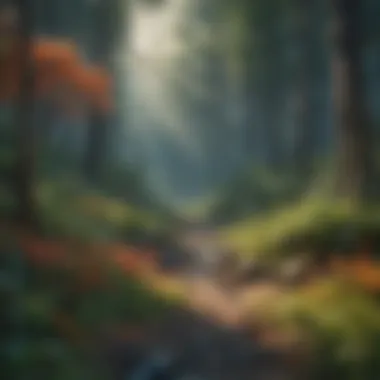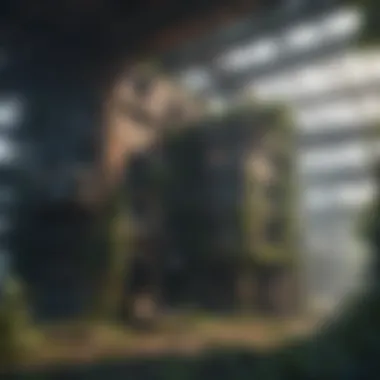Imagining a World Without Humans: Consequences and Insights


Intro
Imagining a world without humans evokes a wide spectrum of thoughts and reflections. The absence of our species leaves behind a unique tapestry of ecological, cultural, and technological narratives. It’s not merely a matter of visualizing empty streets, abandoned buildings, and overgrown parks. It's about understanding the profound implications of such a scenario on the environment and what remains of human endeavors. In short, it's a peek into a realm where nature reclaims its dominion, free from the imprint of humanity.
Key Themes Explored
Theme Highlights
This discussion guides us through several pivotal themes:
- Ecological Resurgence: What happens to ecosystems once human intervention ceases? Will wildlife flourish in areas once dominated by urban development?
- Urban Decay and Regeneration: Cities would change drastically. What becomes of towering skyscrapers and intricate infrastructure? Do they melt back into the earth?
- Cultural Footprints: The remnants of human culture, from literature to art. How do they signify our existence in a world moving forward without us?
- Technological Remnants: Advancements made by humans linger. Do these machines and technologies evolve on their own, or do they rust into silence?
Relevant Quotes and Insights
As we ponder this theme, we reflect upon poignant thoughts:
“Nature never hurries. Atom by atom, little by little, she achieves her work.” – Ralph Waldo Emerson
This quote highlights how, in absence of humanity, nature persistently reclaims and rejuvenates the planet.
Actionable Takeaways
Practical Tips and Strategies
- Observation: Spend time in a natural setting observing the balance and interdependence of wildlife. Witness how nature, even with human influence, seeks to find its equilibrium.
- Awareness: Recognize human impact on the environment. Each small step towards sustainability contributes to improving ecological health.
Suggested Further Reading
Those intrigued by the topic should consider diving into these resources:
- Wikipedia - Human Impact on the Environment
- Britannica - The Anthropocene
- Reddit Community - Environmental Discussions
- Facebook Groups - Eco-conscious Living
By delving into these themes and observations, we begin to gather a comprehensive understanding of our relationship with the planet and the profound ramifications that ensue in the hypothetical absence of humanity. The insights gathered from this exploration are meant to provoke thought and inspire deeper comprehension of our legacy.
Prelude
The topic of a world without humans opens a torrent of possibilities that challenge our understanding of existence and our role in it. It's not merely an exercise in imagination; it forces us to confront existential questions and implications that ripple through every layer of our lives. Why is it crucial to investigate this scenario? For one, it provides us a unique perspective to reflect on the ecological changes that would take place, the cultural artifacts we might leave behind, and the technological advancements that could either die with us or carry on in some altered form.
By diving into this exploration, we can also start to uncover and appreciate the intricate web of connections between humanity and the natural world. Our activities—whether intentional or by oversight—have shaped ecological landscapes significantly. What happens to these fragile systems when the human hand is removed? Curiously, thinking about our absence gives room to reckon with the impacts of climate change, pollution, and urban sprawl.
Furthermore, the thought exercise is not simply environmental. Culture, too, stands to undergo metamorphosis. Literature, art, philosophy—self-expressions built upon the human experience, their legacies might linger. How would future life forms interpret our artistic endeavors? Would they decipher the codes of our civilizations, or would they find remnants of a forgotten world?
This inquiry extends into the realm of technology. Artificial intelligence might still persist, existing in a vacuum devoid of human oversight. What capabilities would remain? Could machines harness resources and create dependencies independent of their creators?
In sum, this article is designed to unpeel the layers of what such a world might look like. The beauty of this inquiry lies in its multitude of angles—ecological, cultural, and technological perspectives that present a canvas for speculation.
Let us embark on this journey through the ruins of what was, contemplating the implications and observations that arise from envisioning a future devoid of humanity. Prepare to delve into ecological shifts, cultural legacies, and technological reactions to our absence. Each section will reveal aspects that illuminate our standing in the world and weave a richer understanding of life beyond humanity.
"We don’t inherit the earth from our ancestors; we borrow it from our children."
— Native American Proverb
This exploration not only captures the essence of the topic, but it reshapes how we envision our legacy and the thriving planet we are a part of. Join me as we navigate these multifaceted dimensions, one inquiry at a time, establishing core insights about our connection to the world.
Defining the Concept of a World Without Us
The notion of a world stripped of human presence sparks a range of considerations across various domains. In exploring this concept, we delve into profound reflections on our existence, the ecosystems we inhabit, and the cultural imprints we leave behind. Understanding a world without us isn't merely an abstract exercise; it compels us to evaluate our impact on the planet and the intricate web of life that surrounds us.
This exploration prompts critical questions, such as: What happens when humanity withdraws its influence? How do ecosystems adjust in the absence of human activity? What remnants of our culture would persist? Engaging with these inquiries enriches our perspective on both humankind and the environment.
Philosophical Considerations
Philosophical reflections on a world devoid of humans revolve around fundamental inquiries about existence and our role in the grand scheme of things. It raises pivotal queries regarding value, meaning, and purpose. If all traces of humanity were erased, how would the essence of existence transform? The interplay between human consciousness and the environment is multifaceted. Our ability to contemplate nature, to ascribe meaning to it, is intricately tied to our being.
For instance, one might ponder whether ecosystems would flourish in liberation from human ignorance. Would forests take back their space, rivers flow freely without dams, and wildlife roam unrestrained? Yet, could the absence of human interpretation lead to a devaluation of the narratives created through art and literature? Thus, an exploration of philosophical considerations leads us not only to the contemplation of the natural world but also to the essence of our own understanding of existence.
Cultural Contexts
Culture shapes our worldview, embedding practices and ideologies within societies. Envisioning a world without people encourages a critical evaluation of what constitutes cultural significance. Would music still echo in valleys? Could the echoes of human creativity linger in the stones of our abandoned cities? Elements of culture—language, religious practices, and artistic expressions—serve as bridges across generations. Without humans, these cultural threads would inevitably unravel.
Imagine a world where the great libraries of knowledge stand silent; collections of thought that span centuries would become mere shadows of their former selves. But would that silence give way to nature’s own narrative? The sound of rustling leaves, the call of a distant bird and the slow reclaiming of human spaces by flora and fauna could itself become a new form of storytelling, unique and rich in its inherent silence.
This exploration emphasizes that, while functionalities of cultural artifacts may fade, their essence—the questions raised by their existence—might echo in the fabric of nature itself.
In summary, defining the concept of a world without humans encourages us to grapple with complex notions of existence, value, and cultural legacy. It challenges us to think critically about what we stand to lose and what important lessons may arise from humanity's absence.
Ecological Responses to Human Absence


Understanding the ecological responses resulting from the absence of humans is crucial for multiple reasons. First and foremost, it sheds light on how ecosystems might reclaim their former splendor when left to their own devices. The intricate web of life that has been eroded due to human activities offers a striking contrast to the thriving communities that can emerge in our absence. This section will delve into the complexities of ecological responses, illustrating the restoration of ecosystems and the evolving nature of biodiversity without human interference.
Restoration of Ecosystems
Wildlife Recovery
Wildlife recovery stands as a significant aspect in any discussion around ecological returns after human absence. When humans step aside, animals that previously faced habitat reduction often begin to reclaim lost territories. For instance, areas that once served as city parks are likely to transform into robust habitats for native species. The undeniable characteristic of wildlife recovery is its ability to enhance ecosystem resilience.
- This reignited presence of animals not only stabilizes the food web but also fosters genetic diversity. These are not just benign benefits; they lay a foundation for ecosystems to adapt to future changes, ensuring their long-term survival.
However, it's also vital to recognize that wildlife recovery has its challenges. The encroachment of certain species might lead to unbalanced ecosystems. For example, the resurgence of predatory animals can disrupt smaller fauna populations. Thus, while wildlife recovery presents a positive image, it remains a nuanced phenomenon.
Vegetation Rebound
Moving on to vegetation rebound, this process encapsulates how plant life flourishes in the absence of human disturbances. Without urban sprawl or agricultural practices, local flora can thrive, creating dense, diverse forests in what once were concrete jungles. This rejoicing of vegetation is often heralded as a beneficial component, as plant cover aids in carbon sequestration, improves soil health, and enhances local climate regulation.
- A unique feature of vegetation rebound is its rapid onset. In relatively short timeframes, such as a few years, flora can begin to dominate the landscape. This remarkable speed of reclamation offers valuable insights into the innate resilience of nature.
Nevertheless, the advantages do not come without their drawbacks. One concern is that non-native plants may also flourish in these vacated spaces, leading to potential ecological hazards. Thus, while vegetation rebound often presents a delightful vista, it may not always represent a purely beneficial change.
Changes in Biodiversity
Species Adaptation
The idea of species adaptation in a post-human world opens up an intriguing line of inquiry. Over generations, species that once had to compete for resources with humans can start altering their behaviors and reproductive strategies. An interesting aspect here is the potential for accelerated evolution. As environments shift without human pressures, evolution might operate at a faster pace, leading to the development of new traits suited to these altered surroundings.
- Notably, this adaptation could yield species better suited for survival amid changing climates and habitats. In this context, species adaptation becomes both a survival strategy and a profound evolutionary dialogue.
Yet, it’s not all roses in the garden. Some species might not adapt quickly enough, thus risking extinction in their transformation. This duality highlights the complexity of ecological responses and poses insurmountable questions about survival in a new ecological landscape.
Novel Ecosystems
Last but not least, the emergence of novel ecosystems cannot be overlooked. As landscapes change and shift in the absence of human influence, ecosystems form that didn’t previously exist. These ecosystems may blend elements of the previous environments, leading to unprecedented species interactions and community structures. The fascinating characteristic of novel ecosystems is their potential to foster entirely new forms of biodiversity.
- For example, regions that were once agricultural could evolve into mixed forests with species adapted to a new mix of light, water, and soil conditions. This innovation in complexity can result in rich biological diversity that goes beyond what currently exists.
However, the novelty may not always translate into benefits. As these new ecosystems can sometimes lead to instability, the long-term viability of such biocommunities remains a point for consideration. Such dynamics warrant deeper understanding to ascertain the implications of these emerging life forms in a post-human era.
"In the grand tapestry of existence, the absence of one thread can lead to an unexpected pattern."
In sum, exploring ecological responses to human absence not only enhances our understanding of nature's resilience but also serves as a reflection on the ecosystems we've altered. The process of recovery and adaptation underscores the complexity and subtlety of life, encouraging a broader appreciation for the planet’s capacity to regenerate.
The Fate of Urban Environments
In a world stripped of humanity, urban environments transform into arenas where nature reclaims its territory. This topic is vital not only for understanding the immediate physical changes that would occur but also for grasping the profound implications of these shifts on biodiversity and ecological balances. Urban areas, often viewed as sterile and controlled landscapes, would morph into wild ecosystems. Here’s a closer look at how the existing structures might falter and allow life to flourish anew.
Dismantling Infrastructure
Decay and Decomposition
The decay and decomposition of urban infrastructure would be a key focus in the absence of human care. Everything from skyscrapers to roads would succumble to the relentless forces of weather and time. Concrete and steel, once symbols of human progress, would corrode and collapse. This not only demonstrates the impermanence of human creations but also initiates an ecological revival. As structures crumble, the freed space becomes a breeding ground for new life.
Key Characteristic: The relentless pace of decay acts as nature's neutralizer against human accomplishments, reintegrating built environments into a natural landscape.
The degradation processes, while seemingly destructive, could be regarded as beneficial in resetting an environmentally imbalanced area. Nutrients released from decomposing materials invite flora and fauna, establishing new ecosystems.
Unique Feature: Nature is exceptionally efficient, turning remnants of our civilization into fertile grounds for regrowth. The advantages far exceed the disadvantages, suggesting a fascinating cycle of life where destruction prompts rebirth.
Nature's Encroachment
Nature’s encroachment represents the relentless advance of plant life reclaiming urban territories. This process serves as a crucial reminder of nature's resilience. Buildings taken over by vines and trees would highlight how life persists against all odds.
Key Characteristic: The adaptive forces of ecosystems would work tirelessly to fill voids left by humanity, offering a stark overview of ecological succession.
Nature's ability to occupy these abandoned spaces would not only beautify but also enhance biodiversity by creating habitats for various species. Plants would provide both food and shelter, forming intricate webs of life that replace what once seemed like a barren urban environment.
Unique Feature: The encroachment signifies a dynamic shift toward self-regulating habitats that foster ecological balance. The disadvantages, such as losing historical contexts, might be significant, yet the advantages of restored ecosystems could redefine urban identity in a post-human world.
Urban Wildlife Adaptations
The urban wildlife adaptations represent an exciting aspect of how life would adjust to the absence of humans. Animals that previously avoided populated areas might find their niche in these now quiet environments. They would not only adapt but thrive, as nuances in behavior come to light.
Fauna Migration


Fauna migration would emerge as a crucial component in this evolution. Many species might use urban landscapes as corridors to seek shelter and resources. Old highways become travel routes for wildlife, while empty buildings become temporary homes.
Key Characteristic: This migration reflects an adaptability rarely seen in nature's primes. It suggests resilience against shifting landscapes.
Driven by necessity, animals would explore beyond established territories. This could lead to unforeseen interactions among species that wouldn’t normally meet, prompting unexpected ecological outcomes.
Unique Feature: Fauna migration could reshape the urban landscape into a mosaic of interactions among various groups, resulting in varied ecological niches within a larger framework.
Behavioral Changes
Behavioral changes in urban wildlife would be another interesting dimension to consider. Animals might develop new foraging techniques or even alter their social structures in response to the absence of human-induced disturbances. This capacity for change plays a vital role in survival.
Key Characteristic: The ability to adapt behaviors highlights the fluidity of species in response to ecological pressures, a testament to evolutionary mechanisms at work.
Moreover, animals might start to exhibit bolder behaviors. With humans out of the picture, urban environments could witness a reemergence of wildlife that once thrived in those spaces. The adaptability offered by a vacant city allows wildlife to forge new identities amidst the ruins.
Unique Feature: This transformation would illustrate a remarkable capacity for life to redefine successful survival strategies when faced with new environments. It might also lead to a more noticeable human legacy reflected in the way wildlife reshapes these spaces.
As these urban environments evolve, they offer a poignant reflection on the impermanence of human presence and the enduring tenacity of nature.
Technological Perspectives
The role of technology in a world devoid of human presence raises many compelling questions about what legacy we leave behind and how the remnants of our inventions might navigate existence without us. This section aims to explore not only how technology behaves in the absence of our guidance but also what the dissolution of human input means for the future of these systems.
The Role of Artificial Intelligence
Autonomous Systems in a Vacuum
When we talk about autonomous systems in a vacuum, we're looking at machines that can function without human intervention or oversight. These systems, powered by artificial intelligence, can perform tasks, make decisions, and adapt to their environment independently. Consider the implications of drones that can deliver supplies, or robots that maintain infrastructure. In a post-human world, such machines might operate at their own convenience, running errands for no one.
The key characteristic of these systems is their ability to learn from their surroundings. Suppose a swarm of drones was designed to monitor wildlife populations; in our absence, they might switch focus and adapt their programming to study the changing ecosystems. This adaptability makes them a beneficial notion for understanding how life might persist after our exit. However, the drawback lies in their lack of human-centered reasoning. Without our intervention, their programming may drift away from the purposes we intended.
Potential for Self-Sustainability
Potential for self-sustainability relates to how technology might evolve to maintain itself independent of human technology. Imagine solar panels powering robotic maintenance crews, or water treatment systems utilizing bioreactors that recycle waste into usable energy. Such innovations could lead to a cycle where machines harness resources in a closed loop.
The primary characteristic of this self-sustaining nature is its circular economy. Not only does it minimize waste, but it also enhances longevity in a world where human influence ceases. However, while this idea is appealing, it does come with caveats. An over-reliance on these systems might limit biodiversity, as nature may not find a place free from artificial constructs or imposed structures.
Preservation of Digital Legacies
Data Retention and Erasure
Data retention and erasure examine how our digital existence could survive, or perhaps perish, in silence. In a world without humans, will our archived memories travel through the ether, stored in the vast oceans of data, or will they disintegrate into nothingness? The retention of data serves to preserve the essence of humanity, chronicling our stories for potential future intelligences. On the flip side, the challenge poses a risk; if data isn't actively managed, it could become obsolete or lost in a sea of relentless entropy.
A unique feature of data retention is its scalability—an ever-growing collection of information that catalogues human culture and history. But the risk of erasure, be it through technological obsolescence or physical decay, looms large. One might find that future entities don't understand the context or relevance buried deep within digital archives. This ambiguity raises significant philosophical considerations about how history is remembered or forgotten.
Virtual Continuity of Human Culture
The concept of virtual continuity of human culture brings forth an intriguing idea: how our literary, artistic, and philosophical achievements might echo through time. In a scenario where humans are no longer present, will these digital artifacts still resonate with any emerging forms of life?
What makes this concept remarkable is its potential for ongoing dialogue. In the absence of humans, remnants of our culture could be interpreted anew, creating a bridge across time. However, reliance on digital artifacts also carries the risk of misinterpretation; values and ideas may morph in meaning, creating illusions of continuity that fail to capture the full vibrancy of original thought.
In summary, both technical perspectives on artificial intelligence and the preservation of digital legacies offer profound insights. They remind us of our relationship with technology as both creators and caretakers. As we gaze into a future without us, observing the capabilities and limitations of technology is crucial. This analysis underscores the potential both for resilience and misunderstanding.
"What we create may outlive us, but understanding its relevance requires more than mere existence; it demands context and interpretation."
By navigating through the corridors of technology, the reflections and implications of our absence deepen, allowing us to ponder the legacies we leave behind.
Reflections on Human Legacy
In contemplating a world devoid of humanity, the echoes of our existence linger not only in the biological imprint we leave behind but also in the cultural artifacts that we create. Reflecting on our legacy becomes essential in understanding the profound impact we have had on our planet. The remnants of our civilization—our art, literature, and technologies—hold valuable insights. They are more than just relics; they are windows into our identity, aspirations, and failures. This section aims to ponder what future beings may glean from our collective efforts and creations, providing context that can frame their understanding of existence.
Cultural Artifacts Post-Humanity
Architecture and Art
Architecture stands as a testament to human creativity, shaping the skyline of cities and shaping our relationship with our environment. After humanity's departure, structures such as skyscrapers and monuments may succumb to nature’s relentless reclaiming. Over time, they may morph into something organic, merging with the surrounding flora. The resilience of materials like stone and steel means some will outlast softer, organic forms, which raises questions about the durability and symbolism of these creations.
- Key characteristic: The enduring nature of architectural works reflects human aspirations and societal values.
- Why it’s important: As these structures decay or transform, they become part of a larger ecological narrative.
- Unique feature: Some artistic expressions—like murals or sculptures—carry narratives that could enlighten future observers about human emotions, aspirations, and struggles.
- Advantages: These insights could foster a greater understanding of our species’ reach and its inevitable return to the earth.
- Disadvantages: Conversely, misinterpretations by future beings could lead to skewed perspectives of human intent and societal organization.
Literature and Philosophy
Literature captures human thoughts, emotions, and philosophies. In a post-human scenario, tomes of poetry, novels, and philosophical treatises remain as testaments to our reflective nature. They provide not just stories but the very fabric of our experiences, meditating on life and existence.


- Key characteristic: Literature’s power lies in its ability to articulate complex human emotions and existential queries.
- Importance: These works can serve as reference points for future life forms to decipher the human condition.
- Unique feature: The variation in styles and themes offers a rich tapestry of thought spanning different cultures and eras, illustrating how diverse human encounters and emotions are.
- Advantages: They may inspire future civilizations to consider their own existence and role within the universe.
- Disadvantages: However, the sheer volume and diversity of texts may overwhelm, creating challenges in interpretation.
How Others Might View Us
In the panorama of time, future beings will undoubtedly analyze our existence through their lenses. The reflections derived from our cultural artifacts will shape their understanding of humanity’s essence.
Interpretations by Future Life Forms
The remnants of our civilization are open to scrutiny, and interpretations by future life forms may vary widely. They could project their values and experiences onto our artifacts, leading to understandings that differ starkly from our own intentions.
- Key characteristic: These interpretations could encapsulate diverse perspectives, incorporating elements of curiosity or disdain depending on future values.
- Why it’s a key concern: Depending on their sophistication, future life forms may or may not appreciate the nuances in our expressions.
- Unique feature: The ambiguity of art and writing leaves much open to interpretation, allowing future generations or life forms to extract meaning relevant to their context.
- Advantages: This variability may foster a bridge of understanding, revealing commonalities in the search for meaning.
- Disadvantages: Misinterpretations could lead to an erroneous perception of human values and intentions.
Understanding Human Impact
Human history is a narrative of impact—on ecosystems, societal structures, and the planet itself. The measure of this impact becomes even more critical in a world without us. Future life forms will need to reconstruct the effects humanity birthed, both positive and negative.
- Key characteristic: Human footprints on the earth range from technological innovations to ecological disruptions.
- Why it’s significant: This understanding helps assess the totality of our legacy, informing future decision-making in addressing their own relationship with the planet.
- Unique feature: The dual nature of our impact—on biodiversity, climate, and cultures—provides a complex storyline that future beings will need to unpack.
- Advantages: Such an assessment might cultivate a nuanced appreciation of balance and sustainability in future civilizations.
- Disadvantages: It also risks oversimplification, reducing our rich legacy to mere statistics without a deeper narrative.
As we extend our thoughts beyond our presence, we find that legacy is a living conversation—a dialogue that echoes into the future, awaiting new listeners.
Existential Implications
The idea of what life would be like in a world without humans raises significant existential questions. This topic delves into the essence of existence itself, forcing us to ponder the very nature of value and purpose when humanity no longer dictates the narrative of the earth. By exploring the implications surrounding existence in the absence of people, we can better understand our place within the broader ecological and philosophical landscape.
The Nature of Existence
Value and Meaning in Absence
In the absence of humanity, one might wonder about the enduring value and meaning of life. Without human interpretive frameworks, concepts like beauty, morality, and value shift dramatically. Ecosystems could thrive unencumbered by artificial boundaries or resource exploitation, leading to an existence that is perhaps more harmonious than the one we impose. The sheer resilience of nature highlights its importance; it carries on whether or not we witness it. Through this lens, we see that worth can exist independent of human recognition.
This perspective serves as a healthy reminder of our interconnectedness with all living beings. A distinct advantage here is the realization that legacy may have a more profound interpretation—one not merely tethered to human achievement but also to the vital roles all species and ecosystems play.
However, there's a downside, too. If humans serve as the lens through which many conceive of value, without us, are the experiences and contributions diminished? This question lingers as we consider the essence of existence when humanity steps aside.
The Role of Consciousness
Consciousness is another crucial thread in this tapestry of existential implications. When we consider the role consciousness plays, it prompts inquiries into the understanding and perception of existence. We often believe that conscious beings like humans imbue the world with significance. Yet without humanity, would other life forms also develop awareness that resonates with existence's deeper meanings?
The unique feature of consciousness in this context lies in its potential evolution. Life forms might adapt to their surroundings in unforeseen ways, leading to enriched ecosystems capable of self-perpetuation. If consciousness were to arise in a different fashion, it might manifest as a multitude of alternate intelligences, giving rise to questions about the nature of awareness itself.
One potential drawback here is that the absence of human consciousness could render the world more chaotic, devoid of meaning as we know it. Without a guiding intellect, interpretations of existence could become almost incomprehensible, leaving a void few can fathom.
Potential Resurgence of Life
In imagining life without humans, the notion of resurgence can create a landscape that teems with possibility. In the midst of human absence, evolution opens a new chapter—one where species adapt, change, and possibly thrive.
Human Evolution in Isolation
The idea of isolating human development is certainly thought-provoking. If humanity were to rise again in isolation from its previous context, how would that manifest? Would our adaptation to this new world be inevitable, or would we struggle against it? The key characteristic of human evolution in isolation means a deliberate break from the past, prompting a reevaluation of our biological and cultural heritage.
Such evolution might lead to tremendous growth, yet it invariably poses dangers as well. If humanity no longer shared its achievements or failures, how would we preserve what we know of ethics, art, or science?
Life Beyond Humanity
Life beyond humanity could teem with opportunities for flourishing ecosystems, or it could veer toward chaos. Other species, repurposed in the wake of humanity's absence, could find themselves exploring unexplored territories. New evolutionary paths may emerge from adaptations to liberated environments, enabling life forms to transform themselves.
Key here is the idea that life could revitalize itself without human intervention, leading to “novel ecosystems” that might resemble nothing we've ever known before. This idea is exhilarating but also carries an inherent risk that we must grapple with. In a world completely reshaped by these changes, the remnants of humanity's legacy might be forgotten or misunderstood.
"To envision a world without humans is not only to imagine an absence; it is to contemplate the profound pathways that life may navigate in the emptiness we leave behind."
Ultimately, the topic of existential implications offers insight into both potential futures. It urges us to reflect on our contributions and the nature of existence itself while simultaneously pushing the boundaries of our understanding of life beyond the human experience.
Finale
The final thoughts on a world devoid of humanity bring us to consider not only the implications of such an absence but the underlying significance of our existence in its entirety. Understanding what might happen to our planet when we are no longer its stewards shapes our awareness and respect for the environment, reminding us of the delicate balance that sustains life. This article has illuminated various themes and reflection points that help to underscore the profound interplay between human activity and environmental responses.
Summarizing Key Insights
Throughout our exploration, several important insights emerge. Firstly, the restoration of ecosystems is one of the most promising outcomes anticipated in this scenario. Nature is remarkably resilient, and our absence could lead to the rebound of species and habitats that have long been threatened. This is not merely a hopeful perspective; evidence of ecological recovery can be seen in various instances across abandoned landscapes worldwide, from the untouched Chernobyl Exclusion Zone to derelict urban centers becoming havens for wildlife. Undoubtedly, the lessons learned from this ecological renaissance carry significant implications for conservation strategies today.
In addition to ecological restoration, the evolution of urban environments plays a crucial role. The gradual decay of human-made structures presents an opportunity for a new kind of biodiversity to flourish. Adapting urban wildlife, like raccoons and peregrine falcons, would find niches in the cracks of civilization once paved over by our physical presence. Not only does this survival instinct provide a blueprint for species adaptation, but it also highlights the narrative of resilience among creatures that cohabitated with us, tantalizing us with glimpses of their varied responses to a post-human world.
Reflections on Our Place in the World
Reflecting on our place within this vast web of life, we recognize that humans, while dominant, are but one thread in an intricate tapestry. The existential questions raised in this discourse invite deeper considerations of what it means to be stewards of the Earth. The artifacts we leave behind may speak to future beings, echoing our triumphs and follies, but they will also serve as a reminder of our responsibility towards the environment.
"Our legacy is not merely in what we create but also in what we allow to thrive or wither."
Acknowledging this, we must grapple with the notion that the survival of many species may depend not just on physical interventions but on our willingness to embrace a holistic understanding of sustainability. This calls for an introspection that urges us to re-evaluate our relationship with nature and recognize that our choices today can either nurture life or lead to further untold consequences.















